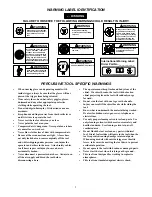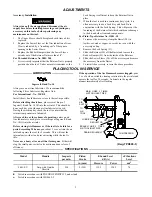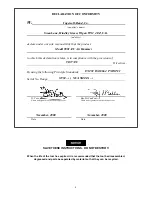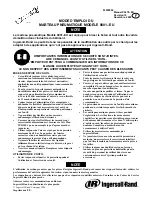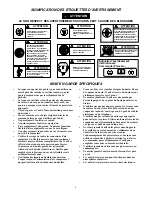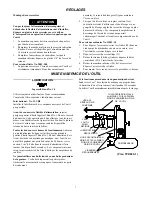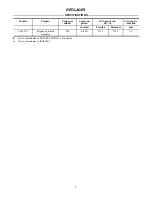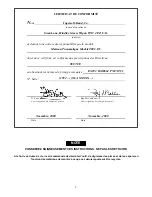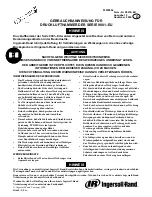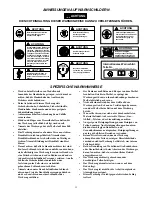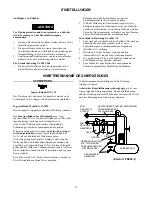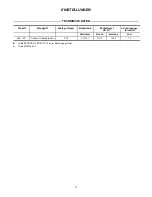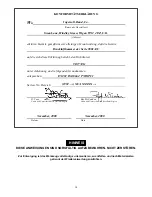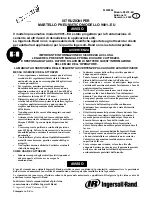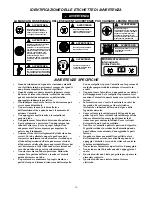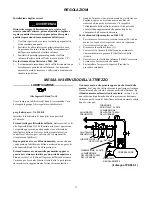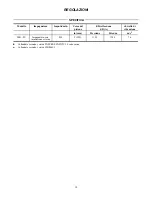
3
ADJUSTMENTS
Accessory Installation
Always turn off the air supply and disconnect the air
supply hose before installing, removing or adjusting any
accessory on this tool or before performing any
maintenance on this tool.
1.
The Upper Sleeve should be replaced each time a bit is
replaced.
2.
Replace the Lower Sleeve at the first indication of wear.
Wear is indicated by a “rounding out” of the square
opening in the Lower Sleeve.
3.
Replace the Rubber Bumper when the Lower Sleeve
extends out of the Retainer Nut more than 1/8”.
For Threaded Retainer No. 9001–200
1.
It is extremely important that the Retainer Nut is properly
positioned on the tool. Under normal circumstances, the
Lock Spring is sufficient to keep the Retainer Nut in
place.
2.
When the tool is used in a continuous duty cycle, it is
often necessary to use a Lock Key and Lock Pin in
conjunction with the Lock Spring. This will prevent the
loosening of the Retainer Nut which could cause damage
to the bit and other front end components.
For Plain–Type Retainer No. 11001–18
1.
To remove the accessory, clamp the Barrel (20) in
leather–covered or copper–covered vise jaws with the
accessory end up.
2.
Remove the Lock Spring (31).
3.
Slide the Retainer (30) off the Barrel and remove the
Rubber Bumper (25) from the inside of the Retainer.
4.
Slide the Lower Sleeve (24) off the accessory and remove
the accessory from the Barrel.
5.
To install the accessory, reverse the above procedure.
PLACING TOOL IN SERVICE
LUBRICATION
Ingersoll–Rand No. 10
Always use an air line lubricator. We recommend the
following Filter–Lubricator–Regulator Unit:
For International – No. 3LUB8
Install the air line lubricator as close to the tool as possible.
Before attaching the air hose, place several drops of
Ingersoll–Rand No. 10 Oil into the air inlet. This should be
done each day even when an air line lubricator is used.
During the working day, check the tool to ensure that the
retainer components are lubricated.
After each two or three hours of operation, unless an air
line lubricator is used, place several drops of Ingersoll–Rand
No. 10 Oil into the air inlet.
Before storing Air Hammer or if the tool is to be idle for a
period exceeding 24 hours, pour about 3 cc or oil into the air
inlet and operate the tool for 5 seconds. This will coat the
internal parts with oil and prevent rusting while the tool is
idle.
Never use a heavy oil or an oil that forms gum. Either will
clog the small parts, restrict valve motion and cause loss of
efficiency.
If the operation of the Air Hammer becomes sluggish, pour
3 cc of a clean, suitable, cleaning solution into the air inlet and
operate the tool for 30 seconds. Lubricate in the regular
manner immediately after flushing.
MAIN LINES 3 TIMES
AIR TOOL INLET SIZE
TO
AIR
SYSTEM
TO
AIR
TOOL
LUBRICATOR
REGULATOR
FILTER
BRANCH LINE 2 TIMES
AIR TOOL INLET SIZE
DRAIN REGULARLY
COMPRESSOR
(Dwg. TPD905–1)
SPECIFICATIONS
Model
Handle
Impacts
per min.
Piston
Stroke
H
Sound Level
dB (A)
♦
Vibrations
Level
in (mm)
Pressure
Power
m/s
2
9001–EU
Grip, with Outside
Throttle
850
9 (229)
115.2
128.2
7.6
H
Tested in accordance with PNEUROP PN8NTC1.2 under load
♦
Tested in accordance with ISO8662–5


